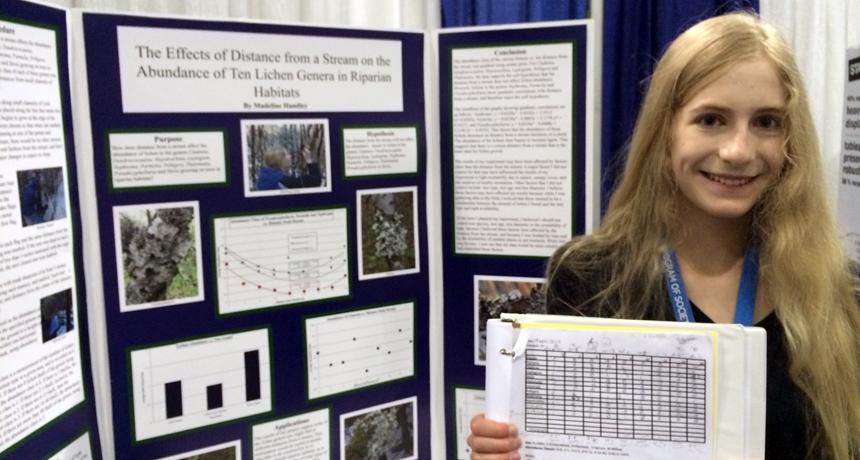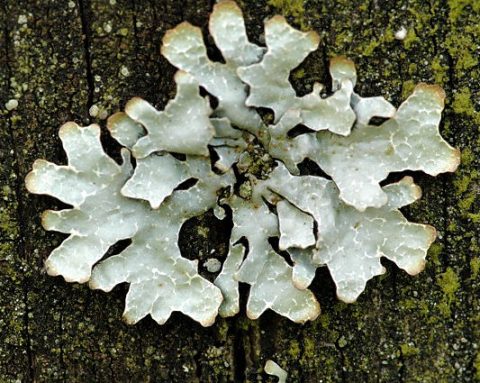Taking a long look at lichen
ISEF finalist Madeline Handley examined lichens near streams in her native Alaska

Madeline Handley studied lichens at a stream near her hometown in Juneau, Alaska. Her results won her a trip to the 2014 Intel International Science and Engineering Fair.
B. Brookshire/SSP
LOS ANGELES – To most people, lichens are just part of the landscape. Clinging bravely to dirt, trees, rock and almost anything else, these small organisms blend in to the background. But Madeline Handley, 16, has always found lichens fascinating. The sophomore at Juneau-Douglas High School in Juneau, Alaska, decided she wanted to learn more about them and their role in the ecosystem of her native state.
Madeline presented her findings at the International Science and Engineering Fair 2014 last week. Created by the Society for Science & the Public and sponsored by Intel, the annual science competition lets high school students from around the globe share their science projects with each other and the public. (SSP also publishes Science News for Students and this blog).
Lichens are not plants, no matter how leafy they look. They are a partnership between a fungus and an alga. The alga uses photosynthesis to make energy from the sun, while the fungus uses the alga’s energy and provides a place for the alga to live. This means that lichens can survive almost anywhere — on trees, houses and even in space.

Lichens are also very sensitive to changes in their environment, particularly near streams. “It’s important to look at stream habitats,” she explains, “because those areas are often affected when the stream changes its course, naturally or because of construction.” The teen decided to look at 10 different genera, or types of lichens, and how their numbers changed with distance from a stream in Juneau.
She laid out three 16-meter (52-foot) long lines, or transects, extending from the edge of her chosen stream. Every two meters (six feet), Madeline placed a flag. She then picked a tree closest to the flag, making sure to select a live tree that was at least three inches across, making it old enough for lichens to have taken up residence. Finally, the teen took data with a magnifying glass and a field guide.
Madeline found that seven of the lichen types she looked at weren’t affected by the distance from the stream. But three were different. The lichen groups Nephroma, Parmelia and Pseudocyphellaria became less common the farther she got from the stream. “The further from the stream, the less there were,” Madeline says. But the trend didn’t continue. “Once I got 10 meters (32 feet) away from the three, the numbers increased again.”
The teen thinks that the differences she saw in where the three lichen types lived might be due to light. “At the edge of the stream, lichen will get a lot of light because there’s not much plant cover,” she explains. “I think the three genera are decreasing as they get further from the light, they can’t photosynthesize as much..”
Madeline hopes her results could help us to understand what happens when we move a stream or build a dam. “It gives us an idea of which lichens you might find closer to or further from a break in the trees,” she says. “It’s important because of the major role that lichens play in our ecosystems.”
Follow Eureka! Lab on Twitter
Power Words
ecosystem A group of interacting living organisms — including microorganisms, plants and animals — and their physical environment within a particular climate. Examples include tropical reefs, rainforests, alpine meadows and polar tundra.
fungus (plural: fungi) Any of a group of unicellular or multicellular, spore-producing organisms that feed on organic matter, both living and decaying. Molds, yeast and mushrooms are all types of fungi.
genus A group of closely related species. For example, the genus Canis — which is Latin for “dog” — includes all domestic breeds of dog and their closest wild relatives, including wolves, coyotes, jackals and dingoes.
lichen A blend of a fungus and an alga. Neither of these organisms is a plant; the lichen isn’t a plant either.
lichenologist A scientist who studies lichens.
nitrogen fixing Nitrogen is an essential element for the proteins in living species. Unfortunately, a lot of nitrogen is found floating free in the atmosphere, where living things cannot use it. Some plants and algae are nitrogen fixers, which can take the nitrogen from the atmosphere and transform it into a form that other living things can use. These organisms are essential parts of the ecosystem.
photosynthesis (verb: photosynthesize)The process by which green plants and some other organisms use sunlight to produce foods from carbon dioxide and water.







